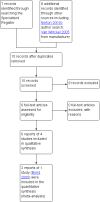Plugs for containing faecal incontinence
- PMID: 26193665
- PMCID: PMC9058784
- DOI: 10.1002/14651858.CD005086.pub4
Plugs for containing faecal incontinence
Abstract
Background: Faecal incontinence is a distressing disorder with high social stigma. Not all people with faecal incontinence can be cured with conservative or surgical treatment and they may need to rely on containment products, such as anal plugs.
Objectives: To assess the performance of different types of anal plugs for containment of faecal incontinence.
Search methods: We searched the Cochrane Incontinence Group Specialised Register, which contains trials identified from the Cochrane Central Register of Controlled Trials (CENTRAL), MEDLINE, MEDLINE In-Process, ClinicalTrials.gov, World Health Organization (WHO) ICTRP and handsearching of journals and conference proceedings (searched 26 May 2015). Reference lists of identified trials were searched and plug manufacturers were contacted for trials. No language or other limitations were imposed.
Selection criteria: Types of studies: this review was limited to randomised and quasi-randomised controlled trials (including crossovers) of anal plug use for the management of faecal incontinence.
Types of participants: children and adults with faecal incontinence.Types of interventions: any type of anal plug. Comparison interventions might include no treatment, conservative (physical) treatments, nutritional interventions, surgery, pads and other types or sizes of plugs.
Data collection and analysis: Two reviewers independently assessed methodological quality and extracted data from the included trials. Authors of all included trials were contacted for clarification concerning methodological issues.
Main results: Four studies with a total of 136 participants were included. Two studies compared the use of plugs versus no plugs, one study compared two sizes of the same brand of plug, and one study compared two brands of plugs. In all included studies there was considerable dropout (in total 48 (35%) dropped out before the end of the study) for varying reasons. Data presented are thus subject to potential bias. 'Pseudo-continence' was, however, achieved by some of those who continued to use plugs, at least in the short-term. In a comparison of two different types of plug, plug loss was less often reported and overall satisfaction was greater during use of polyurethane plugs than polyvinyl-alcohol plugs.
Authors' conclusions: The available data were limited and incomplete, and not all pre-specified outcomes could be evaluated. Consequently, only tentative conclusions are possible. The available data suggest that anal plugs can be difficult to tolerate. However, if they are tolerated they can be helpful in preventing incontinence. Plugs could then be useful in a selected group of people either as a substitute for other forms of management or as an adjuvant treatment option. Plugs come in different designs and sizes; the review showed that the selection of the type of plug can impact on its performance.
Conflict of interest statement
None known.
Figures





Update of
-
Plugs for containing faecal incontinence.Cochrane Database Syst Rev. 2012 Apr 18;(4):CD005086. doi: 10.1002/14651858.CD005086.pub3. Cochrane Database Syst Rev. 2012. Update in: Cochrane Database Syst Rev. 2015 Jul 20;(7):CD005086. doi: 10.1002/14651858.CD005086.pub4. PMID: 22513927 Updated.
References
References to studies included in this review
Bond 2005 {unpublished data only}
-
- Bond C. The anal plug: an evaluation of a novel management option for faecal incontinence. Final report to Chief Scientist Office, Scottish Executive Health Department, Edinburgh 2005. [sr‐incont6653]
-
- Bond C, Youngson G, MacPherson I, Garrett A, Bain N, Donald S, et al. Anal plugs for the management of fecal incontinence in children and adults: a randomized control trial. Journal of Clinical Gastroenterology 2007;41(1):45‐53. [sr‐incont22554] - PubMed
Norton 2001b {published data only}
-
- Norton C, Kamm MA. Anal plug for faecal incontinence. Colorectal Disease 2001;3(5):323‐7. [sr‐incont19091] - PubMed
Pfrommer 2000 {published data only}
-
- Pfrommer W, Holschneider AM, Loffler N, Schauff B, Ure BM. A new polyurethane anal plug in the treatment of incontinence after anal atresia repair. European Journal of Pediatric Surgery 2000;10(3):186‐90. [sr‐incont11013] - PubMed
Van Winckel 2005 {unpublished data only}
-
- Winckel M. Clinical evaluation of a new anal medical device to achieve faecal continence in spina bifida and anal atresia patients. personal communication 2005. [sr‐incont22025]
-
- Winckel M, Biervliet S, Laecke E, Hoebeke P. Is an anal plug useful in the treatment of fecal incontinence in children with spina bifida or anal atresia?. Journal of Urology 2006;176(1):342‐4. [sr‐incont22027] - PubMed
Additional references
Borrie 1992
Brazzelli 2002
-
- Brazzelli M, Shirran E, Vale L. Absorbent products for containing urinary and/or fecal incontinence in adults. Journal of Wound, Ostomy and Continence Nursing 2002;29(1):45‐54. - PubMed
Brown 2013
Coggrave 2014
Fader 2008
Hosker 2007
Jorge 1993
-
- Jorge JM, Wexner SD. Etiology and management of fecal incontinence. Diseases of the Colon & Rectum 1993;36(1):77‐97. - PubMed
Matzel 2003
-
- Matzel KE, Bittorf B, Stadelmaier U, Hohenberger W. Sacral nerve stimulation in the treatment of faecal incontinence. Chirurg 2003;74(1):26‐32. - PubMed
Mavrantonis 1998
-
- Mavrantonis C, Wexner SD. A clinical approach to fecal incontinence. Journal of Clinical Gastroenterology 1998;27(2):108‐21. - PubMed
Mowatt 2007
Norton 2001a
-
- Norton C, Kamm MA. Anal plug for faecal incontinence. Colorectal Disease 2001;3(5):323‐7. - PubMed
Norton 2012
Omar 2013
Perry 2002
Reference Manager 2012
-
- Reference Manager Professional Edition Version 12. New York: Thomson Reuters 2012.
RevMan 2003 [Computer program]
-
- The Nordic Cochrane Centre, The Cochrane Collaboration. Review Manager (RevMan). Version 4.2.5. Copenhagen: The Nordic Cochrane Centre, The Cochrane Collaboration, 2003.
Soffer 2000
-
- Soffer EE, Hull T. Fecal incontinence: a practical approach to evaluation and treatment. American Journal of Gastroenterology 2000;95:1873‐80. - PubMed
Toglia 1998
-
- Toglia MR. Pathophysiology of anorectal dysfunction. Obstetrics and Gynecology Clinics of North America 1998;25(4):771‐81. - PubMed
Publication types
MeSH terms
LinkOut - more resources
Full Text Sources
Other Literature Sources
Research Materials

